Financial Evaluation Report for BIA Ltd. Rebranding Project Assessment
VerifiedAdded on 2022/12/27
|20
|3480
|1
Report
AI Summary
This report provides a detailed financial evaluation of BIA Ltd.'s rebranding project. It begins with an executive summary, followed by an introduction that outlines the company's situation and the report's objectives. The main body addresses key financial concepts, including the cash conversion cycle, break-even analysis, and investment appraisal techniques (NPV and payback period) under optimistic, neutral, and pessimistic scenarios. The report calculates the cash conversion cycle, break-even points, and assesses the project's viability through NPV and payback period methods at different discount rates. The findings indicate that the project is viable under most scenarios, with the report concluding with comments on the company's capital structure, and limitations. The report uses financial ratios and investment appraisal techniques to determine the project's feasibility and offers recommendations for financing options. The report is a comprehensive financial analysis of the rebranding project, covering various financial aspects and providing a clear assessment of its viability.

Title of report- “Financial Ratio Evaluation Report”
Name-
ID-
Word count-2786
Name-
ID-
Word count-2786
Paraphrase This Document
Need a fresh take? Get an instant paraphrase of this document with our AI Paraphraser
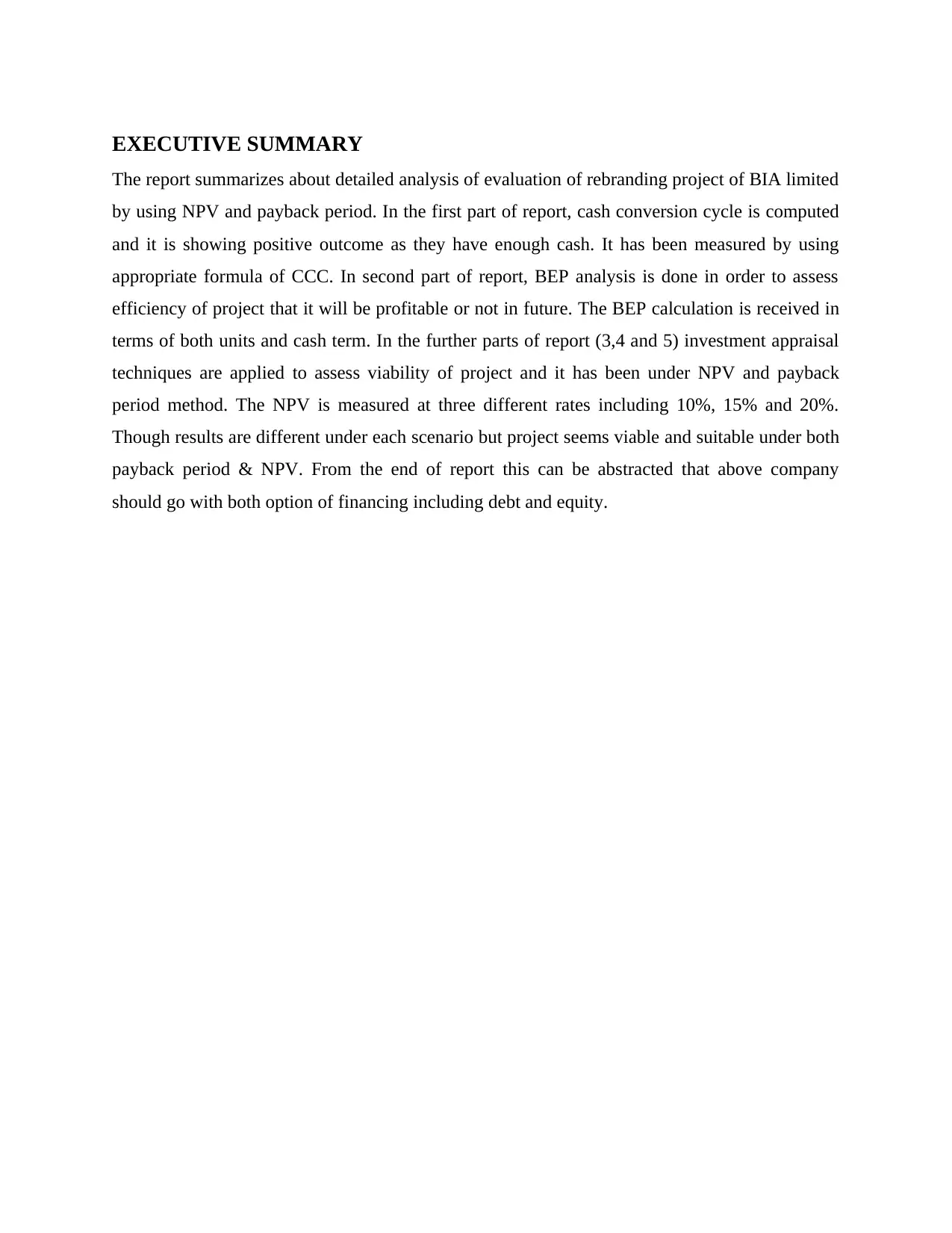
EXECUTIVE SUMMARY
The report summarizes about detailed analysis of evaluation of rebranding project of BIA limited
by using NPV and payback period. In the first part of report, cash conversion cycle is computed
and it is showing positive outcome as they have enough cash. It has been measured by using
appropriate formula of CCC. In second part of report, BEP analysis is done in order to assess
efficiency of project that it will be profitable or not in future. The BEP calculation is received in
terms of both units and cash term. In the further parts of report (3,4 and 5) investment appraisal
techniques are applied to assess viability of project and it has been under NPV and payback
period method. The NPV is measured at three different rates including 10%, 15% and 20%.
Though results are different under each scenario but project seems viable and suitable under both
payback period & NPV. From the end of report this can be abstracted that above company
should go with both option of financing including debt and equity.
The report summarizes about detailed analysis of evaluation of rebranding project of BIA limited
by using NPV and payback period. In the first part of report, cash conversion cycle is computed
and it is showing positive outcome as they have enough cash. It has been measured by using
appropriate formula of CCC. In second part of report, BEP analysis is done in order to assess
efficiency of project that it will be profitable or not in future. The BEP calculation is received in
terms of both units and cash term. In the further parts of report (3,4 and 5) investment appraisal
techniques are applied to assess viability of project and it has been under NPV and payback
period method. The NPV is measured at three different rates including 10%, 15% and 20%.
Though results are different under each scenario but project seems viable and suitable under both
payback period & NPV. From the end of report this can be abstracted that above company
should go with both option of financing including debt and equity.
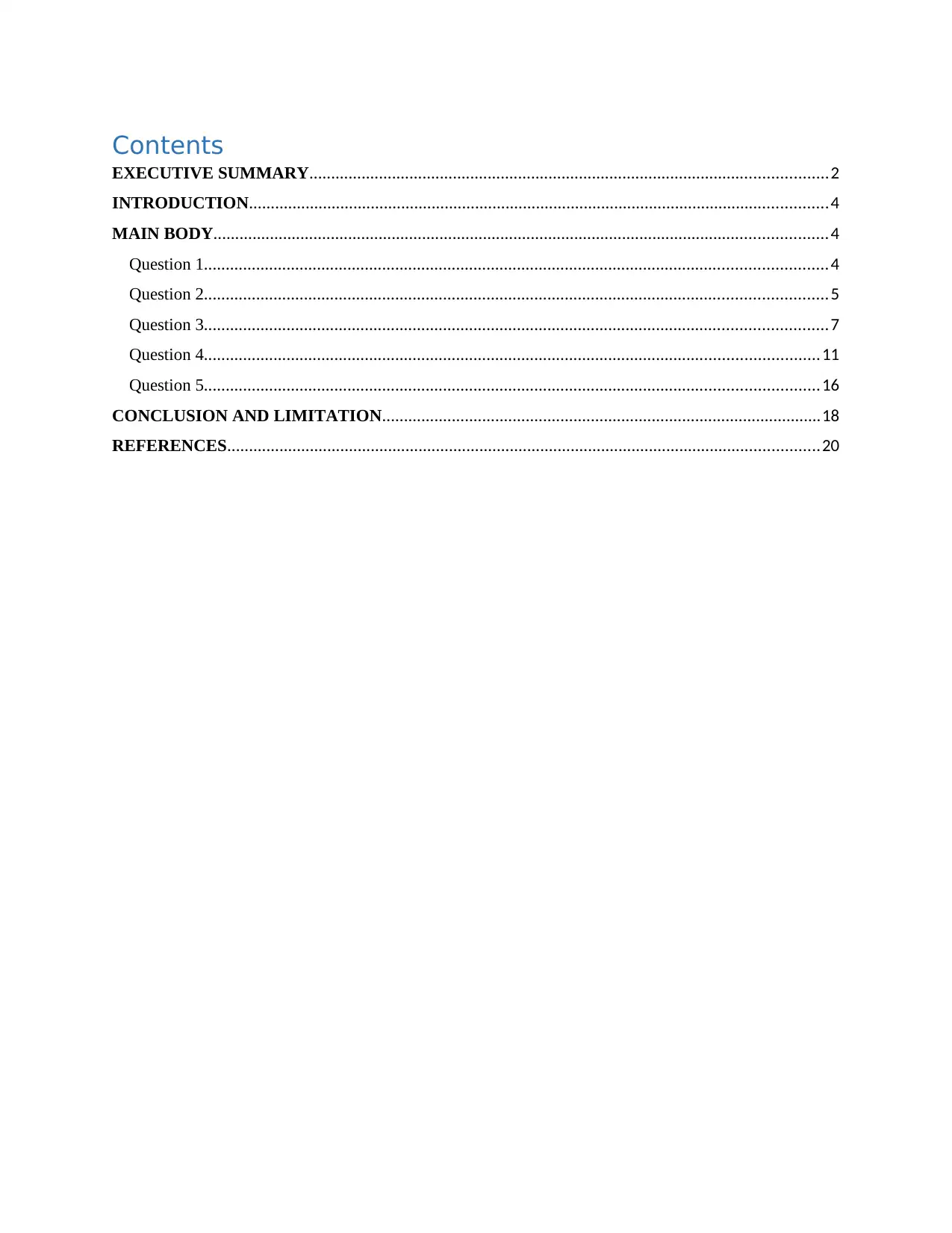
Contents
EXECUTIVE SUMMARY.......................................................................................................................2
INTRODUCTION.....................................................................................................................................4
MAIN BODY.............................................................................................................................................4
Question 1...............................................................................................................................................4
Question 2...............................................................................................................................................5
Question 3...............................................................................................................................................7
Question 4.............................................................................................................................................11
Question 5.............................................................................................................................................16
CONCLUSION AND LIMITATION.....................................................................................................18
REFERENCES........................................................................................................................................20
EXECUTIVE SUMMARY.......................................................................................................................2
INTRODUCTION.....................................................................................................................................4
MAIN BODY.............................................................................................................................................4
Question 1...............................................................................................................................................4
Question 2...............................................................................................................................................5
Question 3...............................................................................................................................................7
Question 4.............................................................................................................................................11
Question 5.............................................................................................................................................16
CONCLUSION AND LIMITATION.....................................................................................................18
REFERENCES........................................................................................................................................20
⊘ This is a preview!⊘
Do you want full access?
Subscribe today to unlock all pages.

Trusted by 1+ million students worldwide

INTRODUCTION
The term financial evaluation can be defined as a process of assessing various kinds of aspect of
a company from perspective of finance (Shapiro, & Hanouna, 2019). In order to do so there are a
range of techniques and approaches which are used by companies. The report is based on a
company named BIA which is a medium sized firm and located in Australia. Currently
company’s performance is not effective and it is declining, therefore they are planning to rebrand
their project. The objective of project report is to assess viability of project from three scenarios
(pessimistic, neutral and optimistic). The report includes detailed information about current cash
conversion cycle of company, BEP, Payback period and NPV analysis of their rebranding
project.
MAIN BODY
Question 1
Current cash conversion of the company: The cash conversion cycle can be defined as a form of
matrix which measure the time that have been taken by a company to transfer their investment
into stock and other resources into cash (Wang, 2019). Below CCC of BIA is measured in such
manner:
Particulars
Curren
t
Inventory conversion period 20
Account receivable collection period 10
Account payable deferral period 30
Operating cycle 30
Cash conversion cycle 0
The term financial evaluation can be defined as a process of assessing various kinds of aspect of
a company from perspective of finance (Shapiro, & Hanouna, 2019). In order to do so there are a
range of techniques and approaches which are used by companies. The report is based on a
company named BIA which is a medium sized firm and located in Australia. Currently
company’s performance is not effective and it is declining, therefore they are planning to rebrand
their project. The objective of project report is to assess viability of project from three scenarios
(pessimistic, neutral and optimistic). The report includes detailed information about current cash
conversion cycle of company, BEP, Payback period and NPV analysis of their rebranding
project.
MAIN BODY
Question 1
Current cash conversion of the company: The cash conversion cycle can be defined as a form of
matrix which measure the time that have been taken by a company to transfer their investment
into stock and other resources into cash (Wang, 2019). Below CCC of BIA is measured in such
manner:
Particulars
Curren
t
Inventory conversion period 20
Account receivable collection period 10
Account payable deferral period 30
Operating cycle 30
Cash conversion cycle 0
Paraphrase This Document
Need a fresh take? Get an instant paraphrase of this document with our AI Paraphraser
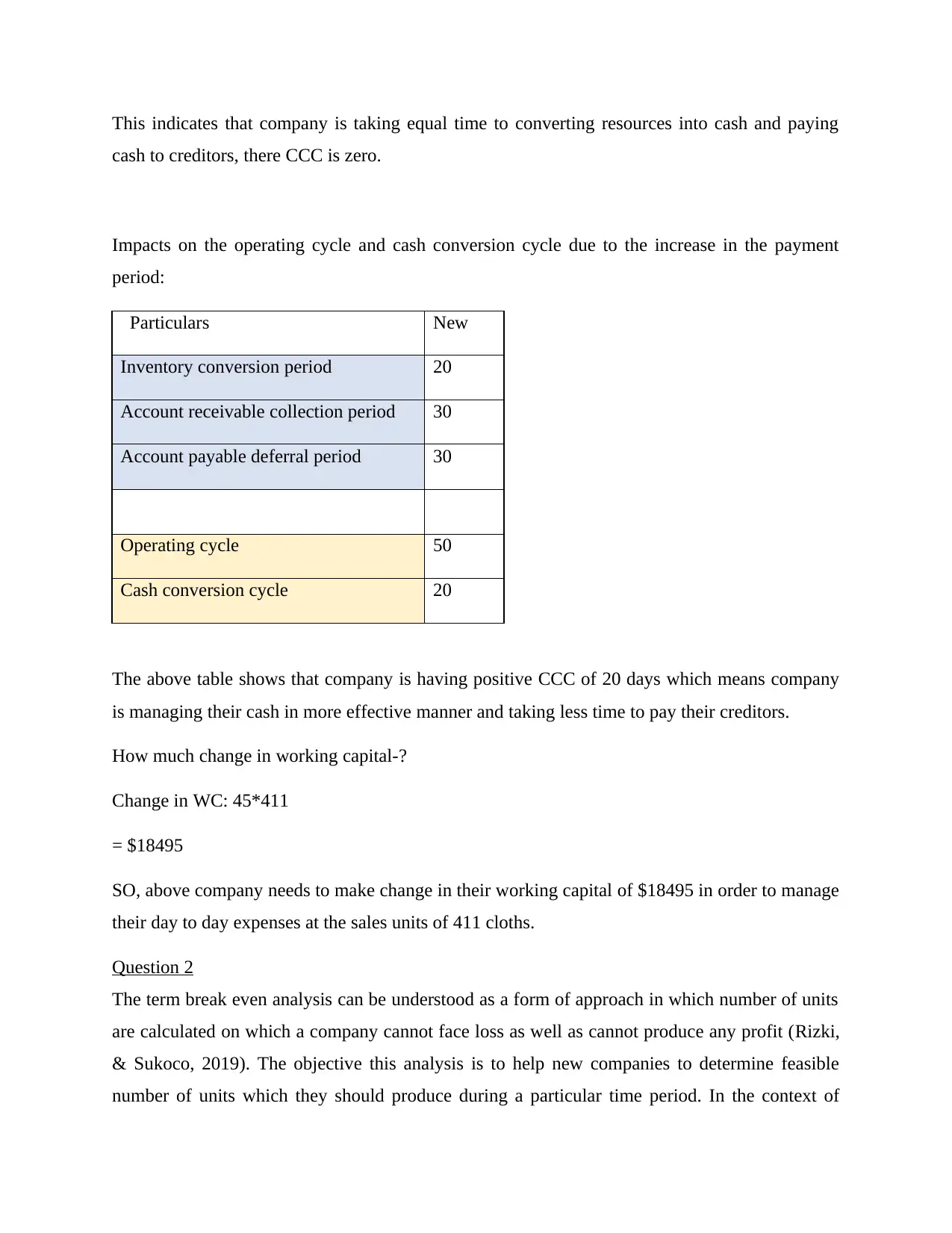
This indicates that company is taking equal time to converting resources into cash and paying
cash to creditors, there CCC is zero.
Impacts on the operating cycle and cash conversion cycle due to the increase in the payment
period:
Particulars New
Inventory conversion period 20
Account receivable collection period 30
Account payable deferral period 30
Operating cycle 50
Cash conversion cycle 20
The above table shows that company is having positive CCC of 20 days which means company
is managing their cash in more effective manner and taking less time to pay their creditors.
How much change in working capital-?
Change in WC: 45*411
= $18495
SO, above company needs to make change in their working capital of $18495 in order to manage
their day to day expenses at the sales units of 411 cloths.
Question 2
The term break even analysis can be understood as a form of approach in which number of units
are calculated on which a company cannot face loss as well as cannot produce any profit (Rizki,
& Sukoco, 2019). The objective this analysis is to help new companies to determine feasible
number of units which they should produce during a particular time period. In the context of
cash to creditors, there CCC is zero.
Impacts on the operating cycle and cash conversion cycle due to the increase in the payment
period:
Particulars New
Inventory conversion period 20
Account receivable collection period 30
Account payable deferral period 30
Operating cycle 50
Cash conversion cycle 20
The above table shows that company is having positive CCC of 20 days which means company
is managing their cash in more effective manner and taking less time to pay their creditors.
How much change in working capital-?
Change in WC: 45*411
= $18495
SO, above company needs to make change in their working capital of $18495 in order to manage
their day to day expenses at the sales units of 411 cloths.
Question 2
The term break even analysis can be understood as a form of approach in which number of units
are calculated on which a company cannot face loss as well as cannot produce any profit (Rizki,
& Sukoco, 2019). The objective this analysis is to help new companies to determine feasible
number of units which they should produce during a particular time period. In the context of
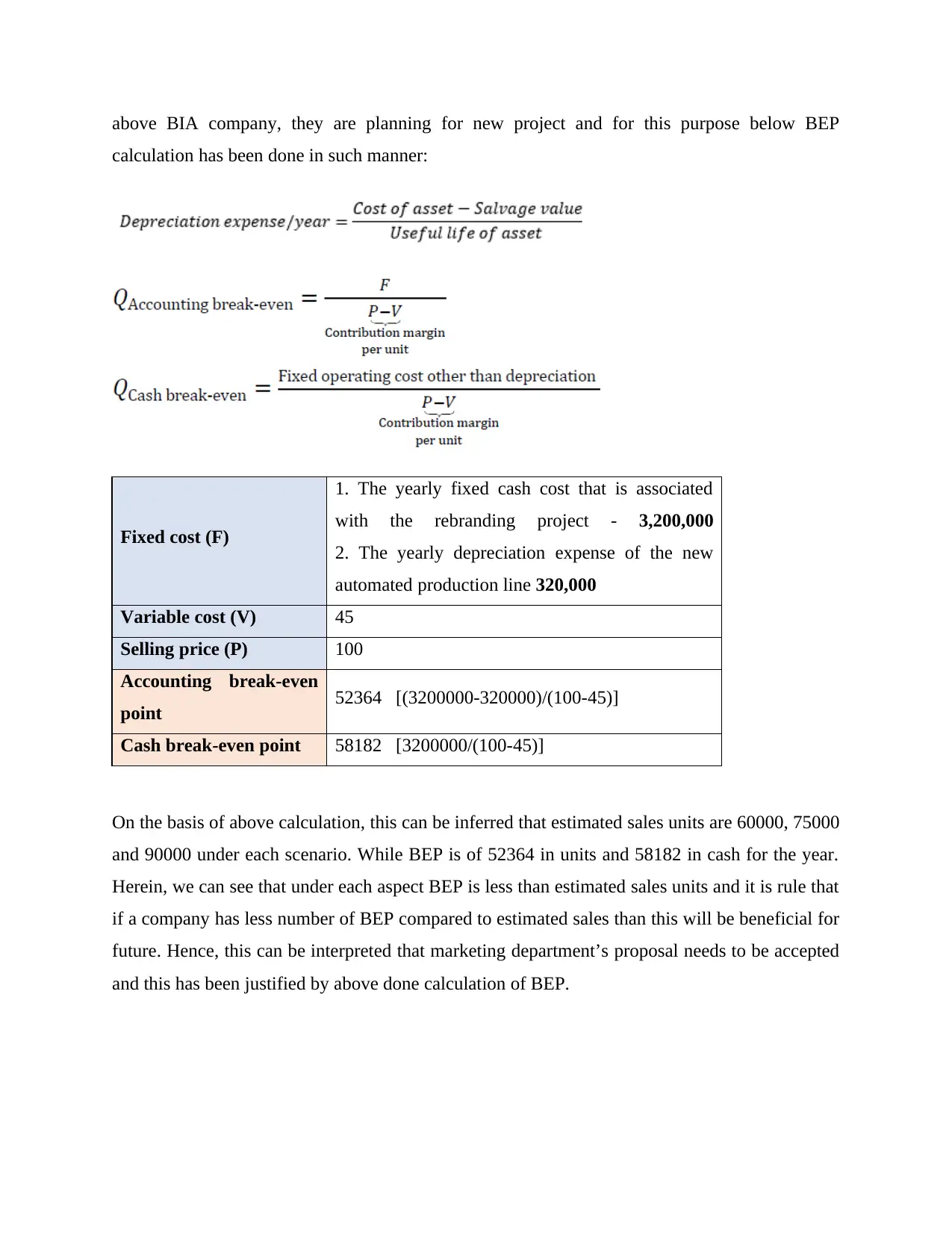
above BIA company, they are planning for new project and for this purpose below BEP
calculation has been done in such manner:
Fixed cost (F)
1. The yearly fixed cash cost that is associated
with the rebranding project - 3,200,000
2. The yearly depreciation expense of the new
automated production line 320,000
Variable cost (V) 45
Selling price (P) 100
Accounting break-even
point 52364 [(3200000-320000)/(100-45)]
Cash break-even point 58182 [3200000/(100-45)]
On the basis of above calculation, this can be inferred that estimated sales units are 60000, 75000
and 90000 under each scenario. While BEP is of 52364 in units and 58182 in cash for the year.
Herein, we can see that under each aspect BEP is less than estimated sales units and it is rule that
if a company has less number of BEP compared to estimated sales than this will be beneficial for
future. Hence, this can be interpreted that marketing department’s proposal needs to be accepted
and this has been justified by above done calculation of BEP.
calculation has been done in such manner:
Fixed cost (F)
1. The yearly fixed cash cost that is associated
with the rebranding project - 3,200,000
2. The yearly depreciation expense of the new
automated production line 320,000
Variable cost (V) 45
Selling price (P) 100
Accounting break-even
point 52364 [(3200000-320000)/(100-45)]
Cash break-even point 58182 [3200000/(100-45)]
On the basis of above calculation, this can be inferred that estimated sales units are 60000, 75000
and 90000 under each scenario. While BEP is of 52364 in units and 58182 in cash for the year.
Herein, we can see that under each aspect BEP is less than estimated sales units and it is rule that
if a company has less number of BEP compared to estimated sales than this will be beneficial for
future. Hence, this can be interpreted that marketing department’s proposal needs to be accepted
and this has been justified by above done calculation of BEP.
⊘ This is a preview!⊘
Do you want full access?
Subscribe today to unlock all pages.

Trusted by 1+ million students worldwide
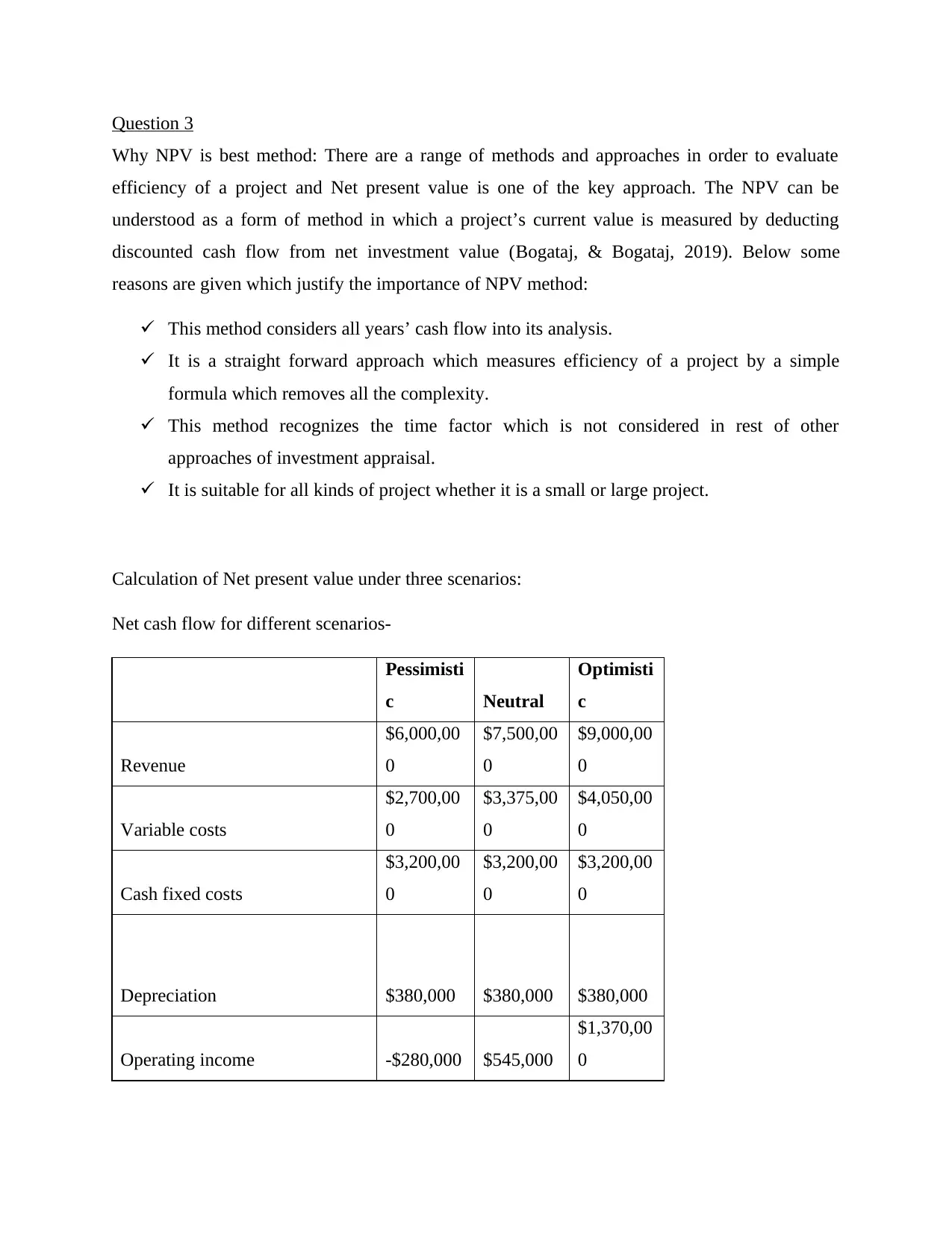
Question 3
Why NPV is best method: There are a range of methods and approaches in order to evaluate
efficiency of a project and Net present value is one of the key approach. The NPV can be
understood as a form of method in which a project’s current value is measured by deducting
discounted cash flow from net investment value (Bogataj, & Bogataj, 2019). Below some
reasons are given which justify the importance of NPV method:
This method considers all years’ cash flow into its analysis.
It is a straight forward approach which measures efficiency of a project by a simple
formula which removes all the complexity.
This method recognizes the time factor which is not considered in rest of other
approaches of investment appraisal.
It is suitable for all kinds of project whether it is a small or large project.
Calculation of Net present value under three scenarios:
Net cash flow for different scenarios-
Pessimisti
c Neutral
Optimisti
c
Revenue
$6,000,00
0
$7,500,00
0
$9,000,00
0
Variable costs
$2,700,00
0
$3,375,00
0
$4,050,00
0
Cash fixed costs
$3,200,00
0
$3,200,00
0
$3,200,00
0
Depreciation $380,000 $380,000 $380,000
Operating income -$280,000 $545,000
$1,370,00
0
Why NPV is best method: There are a range of methods and approaches in order to evaluate
efficiency of a project and Net present value is one of the key approach. The NPV can be
understood as a form of method in which a project’s current value is measured by deducting
discounted cash flow from net investment value (Bogataj, & Bogataj, 2019). Below some
reasons are given which justify the importance of NPV method:
This method considers all years’ cash flow into its analysis.
It is a straight forward approach which measures efficiency of a project by a simple
formula which removes all the complexity.
This method recognizes the time factor which is not considered in rest of other
approaches of investment appraisal.
It is suitable for all kinds of project whether it is a small or large project.
Calculation of Net present value under three scenarios:
Net cash flow for different scenarios-
Pessimisti
c Neutral
Optimisti
c
Revenue
$6,000,00
0
$7,500,00
0
$9,000,00
0
Variable costs
$2,700,00
0
$3,375,00
0
$4,050,00
0
Cash fixed costs
$3,200,00
0
$3,200,00
0
$3,200,00
0
Depreciation $380,000 $380,000 $380,000
Operating income -$280,000 $545,000
$1,370,00
0
Paraphrase This Document
Need a fresh take? Get an instant paraphrase of this document with our AI Paraphraser

Tax -$84,000 $163,500 $411,000
After-tax income -$196,000 $381,500 $959,000
Cash flow $184,000 $761,500
$1,339,00
0
Scenario one (Pessimistic)
Discount Rate 10%
Initial Investment
($3,800,000
)
Year Cash Flows
Discounting
Factor
1 $184,000 $167,272.73
2 $184,000 $152,066.12
3 $184,000 $138,241.92
4 $184,000 $125,674.48
5 $184,000 $114,249.52
6 $184,000 $103,863.20
7 $184,000 $94,421.09
8 $184,000 $85,837.36
9 $184,000 $78,033.96
10 $184,000 $70,939.97
Total of discounted cash flow
$1130600.35
NPV: $1130600.35-$3800000
-$2669400
After-tax income -$196,000 $381,500 $959,000
Cash flow $184,000 $761,500
$1,339,00
0
Scenario one (Pessimistic)
Discount Rate 10%
Initial Investment
($3,800,000
)
Year Cash Flows
Discounting
Factor
1 $184,000 $167,272.73
2 $184,000 $152,066.12
3 $184,000 $138,241.92
4 $184,000 $125,674.48
5 $184,000 $114,249.52
6 $184,000 $103,863.20
7 $184,000 $94,421.09
8 $184,000 $85,837.36
9 $184,000 $78,033.96
10 $184,000 $70,939.97
Total of discounted cash flow
$1130600.35
NPV: $1130600.35-$3800000
-$2669400
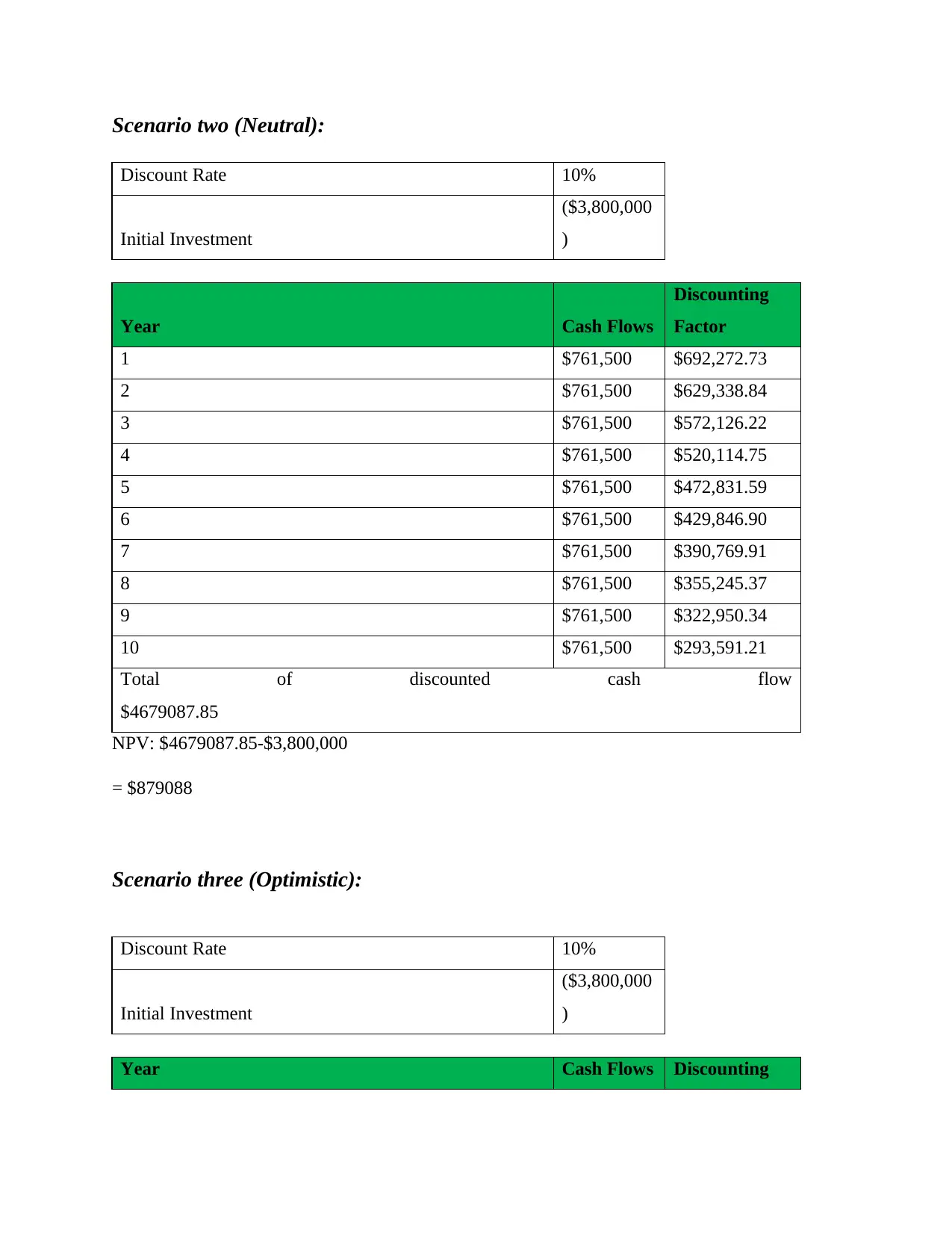
Scenario two (Neutral):
Discount Rate 10%
Initial Investment
($3,800,000
)
Year Cash Flows
Discounting
Factor
1 $761,500 $692,272.73
2 $761,500 $629,338.84
3 $761,500 $572,126.22
4 $761,500 $520,114.75
5 $761,500 $472,831.59
6 $761,500 $429,846.90
7 $761,500 $390,769.91
8 $761,500 $355,245.37
9 $761,500 $322,950.34
10 $761,500 $293,591.21
Total of discounted cash flow
$4679087.85
NPV: $4679087.85-$3,800,000
= $879088
Scenario three (Optimistic):
Discount Rate 10%
Initial Investment
($3,800,000
)
Year Cash Flows Discounting
Discount Rate 10%
Initial Investment
($3,800,000
)
Year Cash Flows
Discounting
Factor
1 $761,500 $692,272.73
2 $761,500 $629,338.84
3 $761,500 $572,126.22
4 $761,500 $520,114.75
5 $761,500 $472,831.59
6 $761,500 $429,846.90
7 $761,500 $390,769.91
8 $761,500 $355,245.37
9 $761,500 $322,950.34
10 $761,500 $293,591.21
Total of discounted cash flow
$4679087.85
NPV: $4679087.85-$3,800,000
= $879088
Scenario three (Optimistic):
Discount Rate 10%
Initial Investment
($3,800,000
)
Year Cash Flows Discounting
⊘ This is a preview!⊘
Do you want full access?
Subscribe today to unlock all pages.

Trusted by 1+ million students worldwide
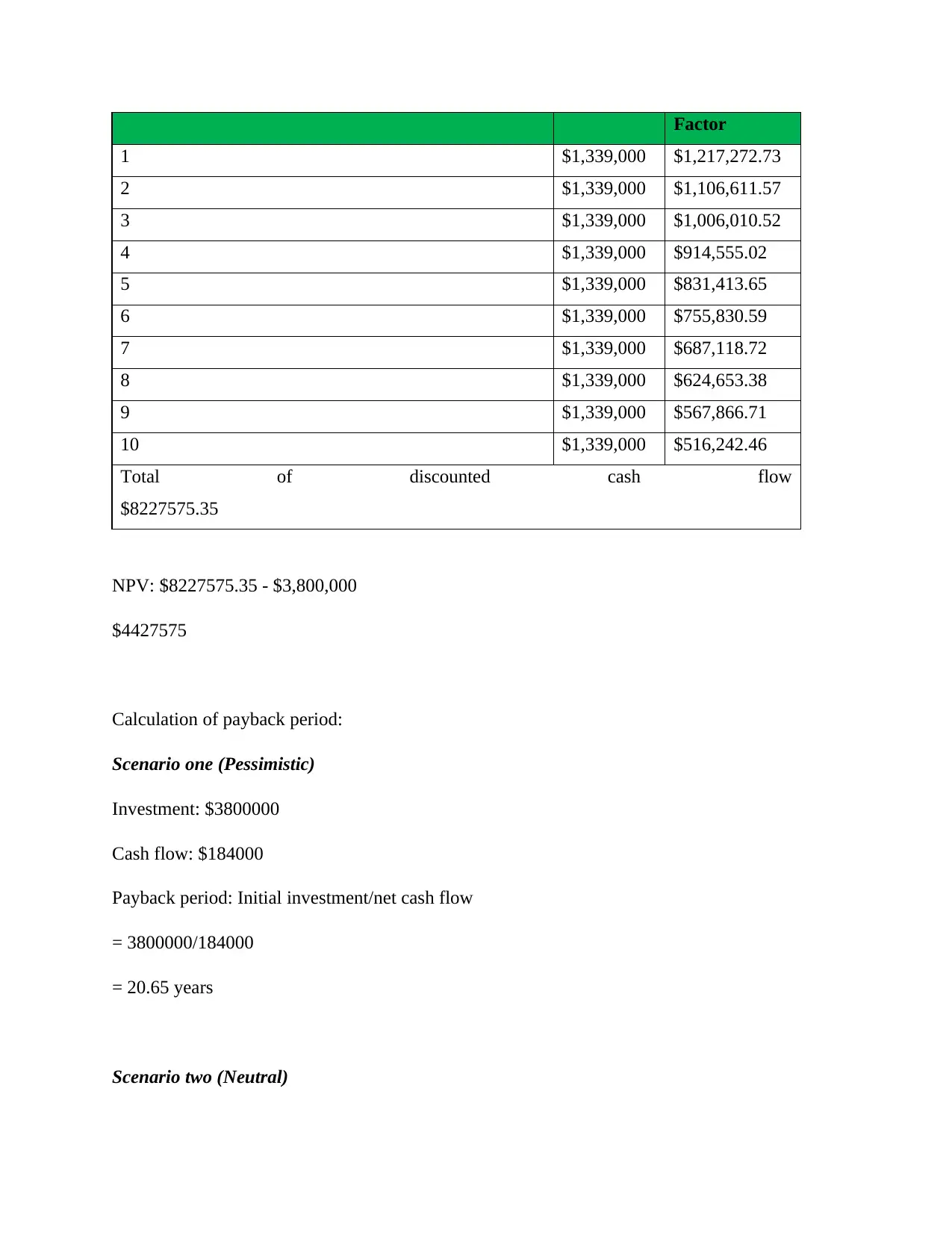
Factor
1 $1,339,000 $1,217,272.73
2 $1,339,000 $1,106,611.57
3 $1,339,000 $1,006,010.52
4 $1,339,000 $914,555.02
5 $1,339,000 $831,413.65
6 $1,339,000 $755,830.59
7 $1,339,000 $687,118.72
8 $1,339,000 $624,653.38
9 $1,339,000 $567,866.71
10 $1,339,000 $516,242.46
Total of discounted cash flow
$8227575.35
NPV: $8227575.35 - $3,800,000
$4427575
Calculation of payback period:
Scenario one (Pessimistic)
Investment: $3800000
Cash flow: $184000
Payback period: Initial investment/net cash flow
= 3800000/184000
= 20.65 years
Scenario two (Neutral)
1 $1,339,000 $1,217,272.73
2 $1,339,000 $1,106,611.57
3 $1,339,000 $1,006,010.52
4 $1,339,000 $914,555.02
5 $1,339,000 $831,413.65
6 $1,339,000 $755,830.59
7 $1,339,000 $687,118.72
8 $1,339,000 $624,653.38
9 $1,339,000 $567,866.71
10 $1,339,000 $516,242.46
Total of discounted cash flow
$8227575.35
NPV: $8227575.35 - $3,800,000
$4427575
Calculation of payback period:
Scenario one (Pessimistic)
Investment: $3800000
Cash flow: $184000
Payback period: Initial investment/net cash flow
= 3800000/184000
= 20.65 years
Scenario two (Neutral)
Paraphrase This Document
Need a fresh take? Get an instant paraphrase of this document with our AI Paraphraser
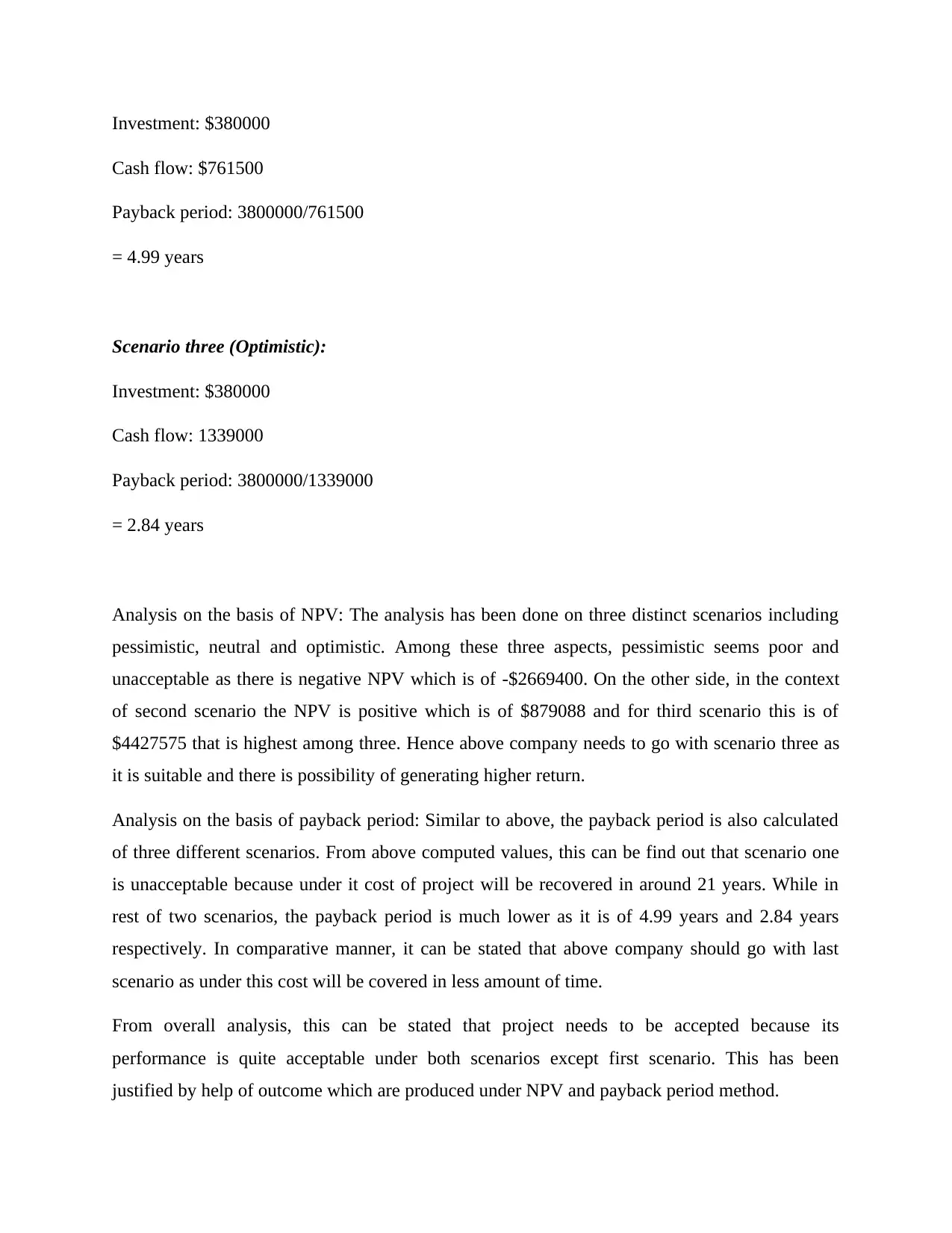
Investment: $380000
Cash flow: $761500
Payback period: 3800000/761500
= 4.99 years
Scenario three (Optimistic):
Investment: $380000
Cash flow: 1339000
Payback period: 3800000/1339000
= 2.84 years
Analysis on the basis of NPV: The analysis has been done on three distinct scenarios including
pessimistic, neutral and optimistic. Among these three aspects, pessimistic seems poor and
unacceptable as there is negative NPV which is of -$2669400. On the other side, in the context
of second scenario the NPV is positive which is of $879088 and for third scenario this is of
$4427575 that is highest among three. Hence above company needs to go with scenario three as
it is suitable and there is possibility of generating higher return.
Analysis on the basis of payback period: Similar to above, the payback period is also calculated
of three different scenarios. From above computed values, this can be find out that scenario one
is unacceptable because under it cost of project will be recovered in around 21 years. While in
rest of two scenarios, the payback period is much lower as it is of 4.99 years and 2.84 years
respectively. In comparative manner, it can be stated that above company should go with last
scenario as under this cost will be covered in less amount of time.
From overall analysis, this can be stated that project needs to be accepted because its
performance is quite acceptable under both scenarios except first scenario. This has been
justified by help of outcome which are produced under NPV and payback period method.
Cash flow: $761500
Payback period: 3800000/761500
= 4.99 years
Scenario three (Optimistic):
Investment: $380000
Cash flow: 1339000
Payback period: 3800000/1339000
= 2.84 years
Analysis on the basis of NPV: The analysis has been done on three distinct scenarios including
pessimistic, neutral and optimistic. Among these three aspects, pessimistic seems poor and
unacceptable as there is negative NPV which is of -$2669400. On the other side, in the context
of second scenario the NPV is positive which is of $879088 and for third scenario this is of
$4427575 that is highest among three. Hence above company needs to go with scenario three as
it is suitable and there is possibility of generating higher return.
Analysis on the basis of payback period: Similar to above, the payback period is also calculated
of three different scenarios. From above computed values, this can be find out that scenario one
is unacceptable because under it cost of project will be recovered in around 21 years. While in
rest of two scenarios, the payback period is much lower as it is of 4.99 years and 2.84 years
respectively. In comparative manner, it can be stated that above company should go with last
scenario as under this cost will be covered in less amount of time.
From overall analysis, this can be stated that project needs to be accepted because its
performance is quite acceptable under both scenarios except first scenario. This has been
justified by help of outcome which are produced under NPV and payback period method.
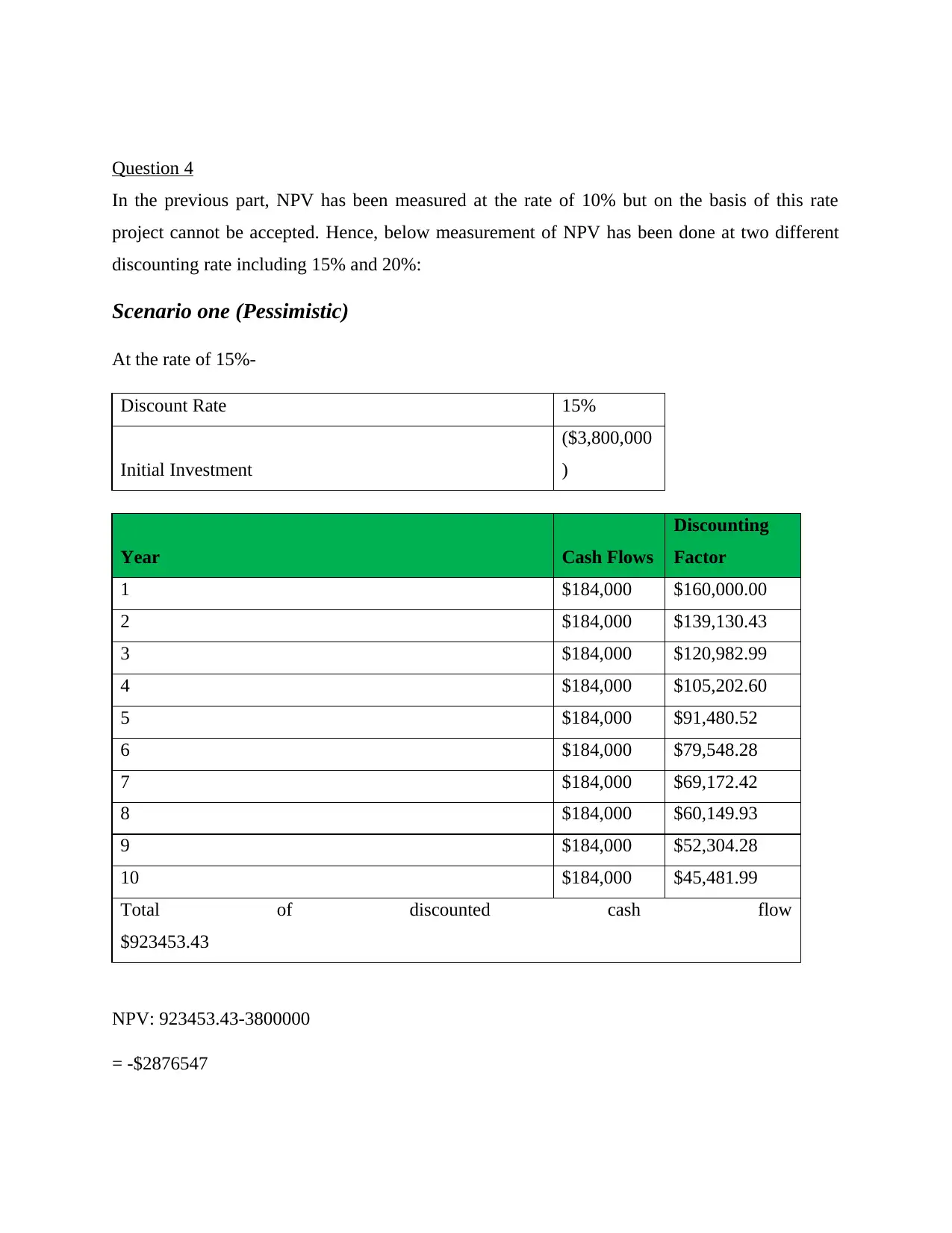
Question 4
In the previous part, NPV has been measured at the rate of 10% but on the basis of this rate
project cannot be accepted. Hence, below measurement of NPV has been done at two different
discounting rate including 15% and 20%:
Scenario one (Pessimistic)
At the rate of 15%-
Discount Rate 15%
Initial Investment
($3,800,000
)
Year Cash Flows
Discounting
Factor
1 $184,000 $160,000.00
2 $184,000 $139,130.43
3 $184,000 $120,982.99
4 $184,000 $105,202.60
5 $184,000 $91,480.52
6 $184,000 $79,548.28
7 $184,000 $69,172.42
8 $184,000 $60,149.93
9 $184,000 $52,304.28
10 $184,000 $45,481.99
Total of discounted cash flow
$923453.43
NPV: 923453.43-3800000
= -$2876547
In the previous part, NPV has been measured at the rate of 10% but on the basis of this rate
project cannot be accepted. Hence, below measurement of NPV has been done at two different
discounting rate including 15% and 20%:
Scenario one (Pessimistic)
At the rate of 15%-
Discount Rate 15%
Initial Investment
($3,800,000
)
Year Cash Flows
Discounting
Factor
1 $184,000 $160,000.00
2 $184,000 $139,130.43
3 $184,000 $120,982.99
4 $184,000 $105,202.60
5 $184,000 $91,480.52
6 $184,000 $79,548.28
7 $184,000 $69,172.42
8 $184,000 $60,149.93
9 $184,000 $52,304.28
10 $184,000 $45,481.99
Total of discounted cash flow
$923453.43
NPV: 923453.43-3800000
= -$2876547
⊘ This is a preview!⊘
Do you want full access?
Subscribe today to unlock all pages.

Trusted by 1+ million students worldwide
1 out of 20
Related Documents
Your All-in-One AI-Powered Toolkit for Academic Success.
+13062052269
info@desklib.com
Available 24*7 on WhatsApp / Email
![[object Object]](/_next/static/media/star-bottom.7253800d.svg)
Unlock your academic potential
Copyright © 2020–2025 A2Z Services. All Rights Reserved. Developed and managed by ZUCOL.





